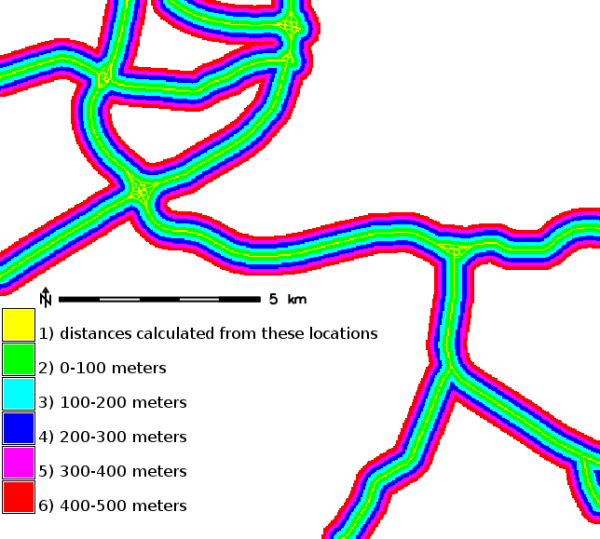
Note: This document is for an older version of GRASS GIS that will be discontinued soon. You should upgrade, and read the current manual page.
NAME
r.buffer - Creates a raster map showing buffer zones surrounding cells that contain non-NULL category values.KEYWORDS
raster, bufferSYNOPSIS
Flags:
- -z
- Ignore zero (0) data cells instead of NULL cells
- --overwrite
- Allow output files to overwrite existing files
- --help
- Print usage summary
- --verbose
- Verbose module output
- --quiet
- Quiet module output
- --ui
- Force launching GUI dialog
Parameters:
- input=name [required]
- Name of input raster map
- output=name [required]
- Name for output raster map
- distances=float[,float,...] [required]
- Distance zone(s)
- units=string
- Units of distance
- Options: meters, kilometers, feet, miles, nautmiles
- Default: meters
Table of contents
DESCRIPTION
r.buffer creates a new raster map showing buffer (a.k.a. "distance" or "proximity") zones around all cells that contain non-NULL category values in an existing raster map. The distances of buffer zones from cells with non-zero category values are user-chosen and must be positive value(s). Suppose, for example, that you want to place buffer zones around roads. This program could create the raster map shown below on the right based on road information contained in the raster map shown on the left.
000000000000000000000000 222233333333333333444444
111000000000000000000000 111222222222223333333333
000111111111100000000000 222111111111122223333333
000000001000011100000000 332222221222211122222222
000000001000000011111111 333333321233222211111111
000000001000000000000000 433333321233333222222222
000000001000000000000000 444443321233333333333333
000000001000000000000000 444443321233443333333333
000000001000000000000000 444443321233444444444444
Category 0: No roads
Category 1: Road location
Category 2: Buffer Zone 1 around roads
Category 3: Buffer Zone 2 around roads
Category 4: Buffer Zone 3 around roads
NOTES
The user has the option of identifying up to 250 continuous zones. The zones are identified by specifying the upper limit of each desired zone (r.buffer assumes that 0 is the starting point). "Continuous" is used in the sense that each category zone's lower value is the previous zone's upper value. The first buffer zone always has distance 0 as its lower bound. Buffer distances can be specified using one of five units with the units parameter.Distances from cells containing the user-specified category values are calculated using the "fromcell" method. This method locates each cell that contains a category value from which distances are to be calculated, and draws the requested distance rings around them. This method works very fast when there are few cells containing the category values of interest, but works slowly when there are numerous cells containing the category values of interest spread throughout the area.
r.buffer measures distances from center of cell to center of cell using Euclidean distance measure for planimetric locations (like UTM) and using ellipsoidal geodesic distance measure for latitude/longitude locations.
r.buffer calculates distance zones from all cells having non-NULL category values in the input map. If the user wishes to calculate distances from only selected input map category values, the user should run (for example) r.reclass prior to r.buffer, to reclass all categories from which distance zones are not desired to be calculated into category NULL.
The -z flag can be used to ignore raster values of zero instead of NULL values in the input raster map.
When working with massive raster regions consider the r.buffer.lowmem module if RAM use becomes a problem. The lowmem version can be > 40x slower, but will work with minimal memory requirements. The classic r.buffer should be able to deal with raster maps of 32000x32000 size on a system with 1 GB RAM, and rasters of 90000x90000 on a system with 8 GB RAM without going into swap.
EXAMPLE
In the following example (North Carolina sample dataset), the buffer zones would be (in the default map units of meters): 0-100, 101-200, 201-300, 301-400 and 401-500.g.region raster=roadsmajor -p r.buffer input=roadsmajor output=roadsmajor_buf distances=100,200,300,400,500
r.category input=roads.buf
1 distances calculated from these locations
2 0-100 meters
3 100-200 meters
4 200-300 meters
5 300-400 meters
6 400-500 meters

Distances to road
SEE ALSO
r.buffer.lowmem, r.grow, v.bufferg.region, r.cost, r.distance, r.grow.distance, r.mapcalc, r.reclass
AUTHORS
Michael Shapiro, U.S. Army Construction Engineering Research LaboratoryJames Westervelt, U.S. Army Construction Engineering Research Laboratory
SOURCE CODE
Available at: r.buffer source code (history)
Latest change: Thursday Feb 03 11:10:06 2022 in commit: 547ff44e6aecfb4c9cbf6a4717fc14e521bec0be
Note: This document is for an older version of GRASS GIS that will be discontinued soon. You should upgrade, and read the current manual page.
Main index | Raster index | Topics index | Keywords index | Graphical index | Full index
© 2003-2023 GRASS Development Team, GRASS GIS 8.2.2dev Reference Manual